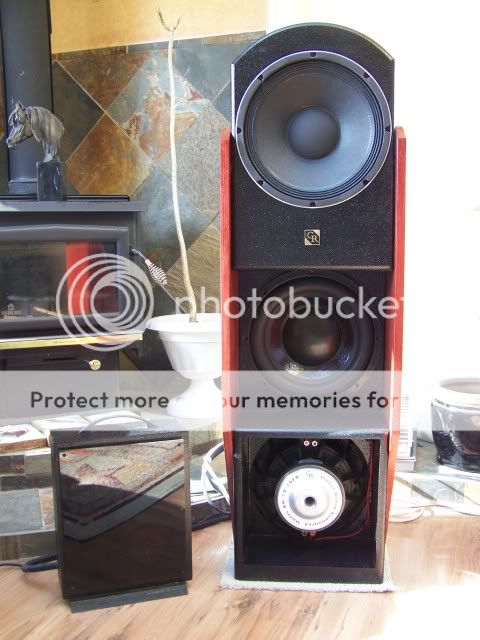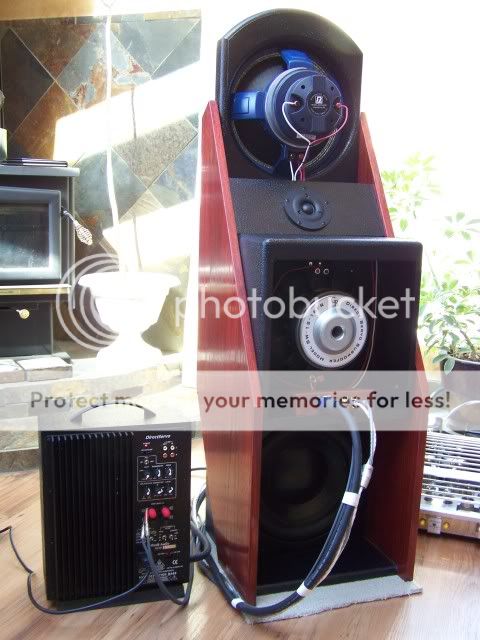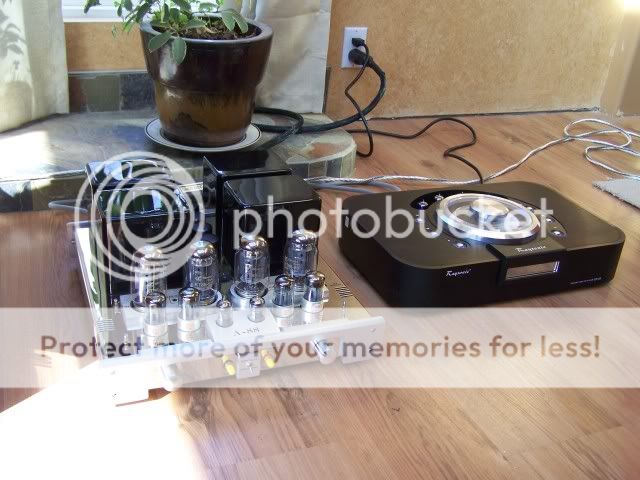My V-1s from GR research are coaxial......I love em
PS audio 12" open baffle....mounted on open baffle servo subs
These are the best I have owned, drive them with a GF A-88 and the source
is a Raysonic 128....absolutely stunning!
Built from a kit in my garage about 1 1/2 yrs ago....as conventional as I get.
Next.....my first horns........



PS audio 12" open baffle....mounted on open baffle servo subs
These are the best I have owned, drive them with a GF A-88 and the source
is a Raysonic 128....absolutely stunning!
Built from a kit in my garage about 1 1/2 yrs ago....as conventional as I get.
Next.....my first horns........



Yes....."P" Audio......late night posting......
The pair I built were one of the first.....soon after the the designer did open the compression driver and dropped the rear tweeter. It is how the kit is offered now.
The x-over would have to be altered to open the back and I really am happy with them
the way they are. Treble was a concern when I purchased them....thought they would beam....but they are wonderful they way they are.....thanks
The pair I built were one of the first.....soon after the the designer did open the compression driver and dropped the rear tweeter. It is how the kit is offered now.
The x-over would have to be altered to open the back and I really am happy with them
the way they are. Treble was a concern when I purchased them....thought they would beam....but they are wonderful they way they are.....thanks
Anyone gave it a listen?
No air noise that I could hear, and we were playing the IQ30 pretty loud! The bigger speakers had a few problems I couldn't identify very well, but the tiny little IQ30 was very nice.
I'm thinking of this driver: http://profesional.beyma.com/ingles/pdf/12XA30Nd.pdf, any opinions?
They're offered as an upgrade to the Eminence/Selenium coaxials in the Emerald Physics CS3, and I already liked the CS3. I'm not planning OB though, just a plain ported box.
There's also the 8 and 6 inchers at the same site, the specs on the 6 look very nice for small monitors though I have more small speakers than I can shake a stick at.
The 12XA30Nd and its bigger brother 15XA38Nd are really excellent drivers but come at a cost.I'm thinking of this driver: http://profesional.beyma.com/ingles/pdf/12XA30Nd.pdf, any opinions?
A friend of mine is currently doing a commercial passive design with the 12" and his comments on the sound quality are pretty enthusiastic as were the comments from first beta testers, wrt to detail and dynamics. I just bought the 15" and will try it in BR fullrange (active) first but might also check out OB operation (+Sub).
Out of the box the drivers sound pretty harsh, they definitely need a serious burn-in. AFAIK they are used in a variety of commercial designs (for HiFi, that is).
- Klaus
^^I'm guessing they'll be around half the price of a two-way Scanspeak Revelator system after shipping and imports in my country 
I'm going active too, my room is pretty small so I'm thinking just about 50 watts on the woofer and 25 on the tweeter should be good enough for pretty loud listening. Do you think the tweeter will take a 7-800Hz crossover at these power levels?
I just hope I get a reply from the distributor soon.
I'm going active too, my room is pretty small so I'm thinking just about 50 watts on the woofer and 25 on the tweeter should be good enough for pretty loud listening. Do you think the tweeter will take a 7-800Hz crossover at these power levels?
I just hope I get a reply from the distributor soon.
Do you have a reference or more information on the BBC approach? Is it similar to the JBL's "Radiation Boundary Integrator" approach?Still, coaxs are great for custom in-wall. I designed a model at PSB that used a waveguide on the tweeter. A little extra directivity meant virtually no reflection from the woofer behind, smooth response and a nice ability to aim the treble as desired.
PSB Speakers - CW180R In-Wall Speaker
Another model that worked was a BBC design that had a tweeter mounted on a perforated plate in front of the woofer. The plate was transparent enough for the bass to get through and solid enough to effectively baffle the tweeter.
David
Do you have a reference or link to the pictures you saw? An idea of the date would also be useful such as 50s, 70s or whenever. Searching the bbc site and googling has so far failed to throw up a link but that may well be my lack of searching skills.
David's description does not seem to be a tweeter on a plate in the manner of ME Geithain but perhaps I am projecting. In the pictures did a plate with holes fully cover the mid/woofer or did a solid plate without holes partially cover it?
David's description does not seem to be a tweeter on a plate in the manner of ME Geithain but perhaps I am projecting. In the pictures did a plate with holes fully cover the mid/woofer or did a solid plate without holes partially cover it?
Here's one solution for smoother coaxial driver.
Genelec MDC Technology
used in
http://www.genelec.fi/documents/datasheets/DS8260A_2.pdf
Not so easy to use in diy speakers though.
Genelec MDC Technology
used in
http://www.genelec.fi/documents/datasheets/DS8260A_2.pdf
Not so easy to use in diy speakers though.
A load of ME Gethain 906s were sold in the recent Bush House auction. Perhaps it was one of those?Only ever seen them in an ebay ad and can't remember the exact designation.
A quick google showed mostly LS3/5s and it certainly wasn't them.
Might try again later.
Sorry!
That is encouraging. I will keep looking.It was about 10 years ago on ebay, sold by a guy in Surbiton who had a number of other BBC monitors for sale. Except of the tweeter arrangement they looked nothing like Geithains.
The Genelec coaxial driver mentioned in post 31 seems to share some of the attributes of the new Q series and R series drivers from KEF. Namely the smooth transition from the tweeter to the mid/bass cone. The KEF drivers have other aspects which help with dispersion like the "Z" flex surround. Check out the KEF LS50 Thread on the Fullrange forum for more information.
I have a pair of old KEF uniQ's as backups to my DIYs. They definitely have their issues, but some things they do very well (imaging). These are an early generation model, and I have a feeling they've figured some things out in the past 15 years.
The format has great potential, but, unfortunately, is the age of ipods and earpods, I doubt they get the investment in R&D that they deserve. Harmon could do it ... R&D and marketing budget aimed at home theater - the coaxial's natural ally.
Not impressed with my Q1's. Terrible midrange, bad tweeter breakup and lumpy response and imaging not as good as mine. Cheap. But they were cheap! I never heard their top of the line.
Anyway, why are they not more popular? Because no one has made one that is better than we can do with separates for the same cost. I wish they would. I think some of the problem has to do with phase and offset. The very problem we want them to solve. The woofer acts like a horn to the tweeter. That causes a host of issues. So why no really good ones? I guess because it is really hard!
The all new drivers from KEF have been receiving rave reviews from various quarters so they must offer something. Their new LS50 "studio monitor" is £800.00 and employes some very interesting and innovative design features. I am looking forward to hearing them at some point in the future.
- Status
- This old topic is closed. If you want to reopen this topic, contact a moderator using the "Report Post" button.
- Home
- Loudspeakers
- Multi-Way
- Why aren't coaxial speakers more popular?